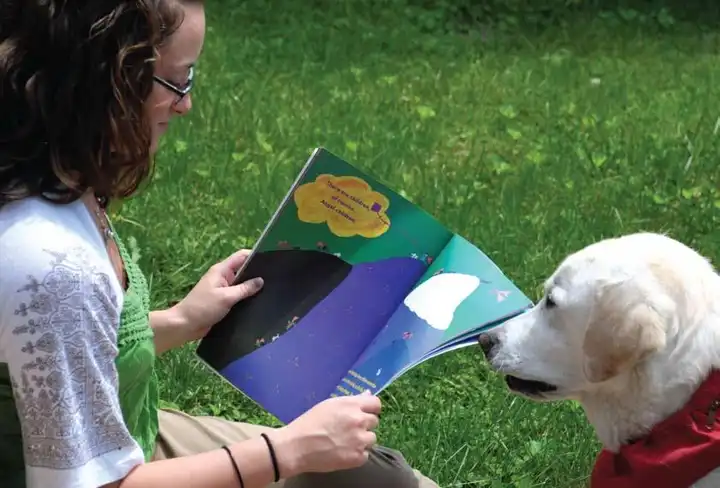
4 minute read
Reading goes to the dogs
Goes to the Dogs Reading By Janet KaCSKOS
When the red scarves go on, Solomon and Justice know it’s time to start reading…well, as much as dogs can read. The two Labrador Retrievers—Solomon, a six-year-old black lab, and Justice, a 13-year-old yellow lab, are owned by Dr. Anne Papalia-Berardi, associate professor of special education at Millersville. She has been involved with therapy dogs for 20 years, certifying each of her own dogs since 1993 to help students struggling with reading and learning.
Advertisement
Her first dog, Casey, a Labrador Retriever/ Golden Retriever mix, accompanied her as an elementary learning support teacher.
“Casey participated in our lessons, and students read to her and wrote stories about her,” explained Papalia-Berardi. Her idea to use therapy dogs to help struggling readers came from a librarian in the School District of Lancaster who began a therapy dog program at Wharton Elementary School, titled “Paws for Reading.” Papalia-Berardi and her dogs were volunteers for three years in the program, and students would come for an hour once a week to read to the dogs.
“The dogs appear to be reading the books because at the end of each line they are given a treat,” says Papalia-Berardi. “The child holds the treat in their hand and moves their hand across the words until the end of the line when the dog is rewarded for helping to ‘read’ with a treat.” Other dogs prefer to cuddle and be petted as the child reads to them.
The program is based on Project Reading Education Assistance Dogs, or
Above: Dr. Papalia-Berardi surrounds herself with innovative teaching approaches. In this case, is Solomon (left) and Justice, also know as Justy). Previous page: Justice listens intently as Jenna Gerstenblith ’09 reads to him from the book, Dog Heaven. Sadly, Justice passed away in June from a rare form of colon cancer.

Project READ. “These programs were designed to help struggling readers improve confidence and skills. Reluctant readers tend to have low self-esteem and are intimidated or anxious about reading and tend not to read,” says PapaliaBerardi. “Children improve their reading skills by reading, and struggling readers are more likely to read in a safe environment. The presence of a dog tends to alleviate stress because dogs don’t notice reading errors and are great listeners.”
Forty-three percent of the students involved in the Paws for Reading program improved by at least 10 Developmental Reading Assessment levels, and 35.7 percent improved at the same rate or better than classmates. Children in the primary grades are generally the target population for a reading program.
At a recent Pennsylvania Council

for Exceptional Children conference, Papalia-Berardi presented “Paws For Reading: Using therapy dogs to motivate struggling readers.”
Some children have a fear of dogs. There are several techniques that can be used to alleviate their fear. One approach is to have the dog “back in” to the child and sit very still within petting range. The dogs enjoy having their backs stroked and children enjoy the touch of the soft fur and gain confidence, especially when the dog reacts in a calm manner. A second technique is to dress the dogs in costumes. Most dogs associate the therapy visits in a positive way. She says, “It is difficult for a child to feel scared if they are laughing or see the dog in a humorous light.”
Therapy dogs are always in training. Both Casey and Justice began training when they were three months old, and Solomon when he was seven weeks old. The training consists of basic obedience, teaching manners and socialization. Dogs also must learn to greet people appropriately, interact well with other dogs, accept petting from a variety of people, walk on a loose leash through crowds and respond to various types of distractions.
Her dogs have accompanied PapaliaBerardi to her classes at Millersville, when she discusses therapy dogs. Justice and Solomon have also competed in national obedience dog shows, placing in the top 10 on many occasions.
Education was always highly valued in Papalia-Berardi’s family. When her father’s parents came to the United States from Italy, they were poor and neither of them could read.
One of her grandfather’s fondest memories was seeing newspapers on porches of people’s homes. “He felt that America was such a land of opportunity because people could learn to read,” says Papalia-Berardi. Her father became a social studies teacher, and later earned a doctorate and worked in higher education. “His opportunity to receive an education changed my life. I wanted to pass this opportunity on to the next generation,” she says.
Combining her love of dogs and teaching is natural for Papalia-Berardi. “One of the best aspects of the therapy dog reading program is that the dogs are consistently glad to see the children and don’t mind repetition. The dogs gladly listen to the same book time and again just to have the opportunity to be with a child.”




